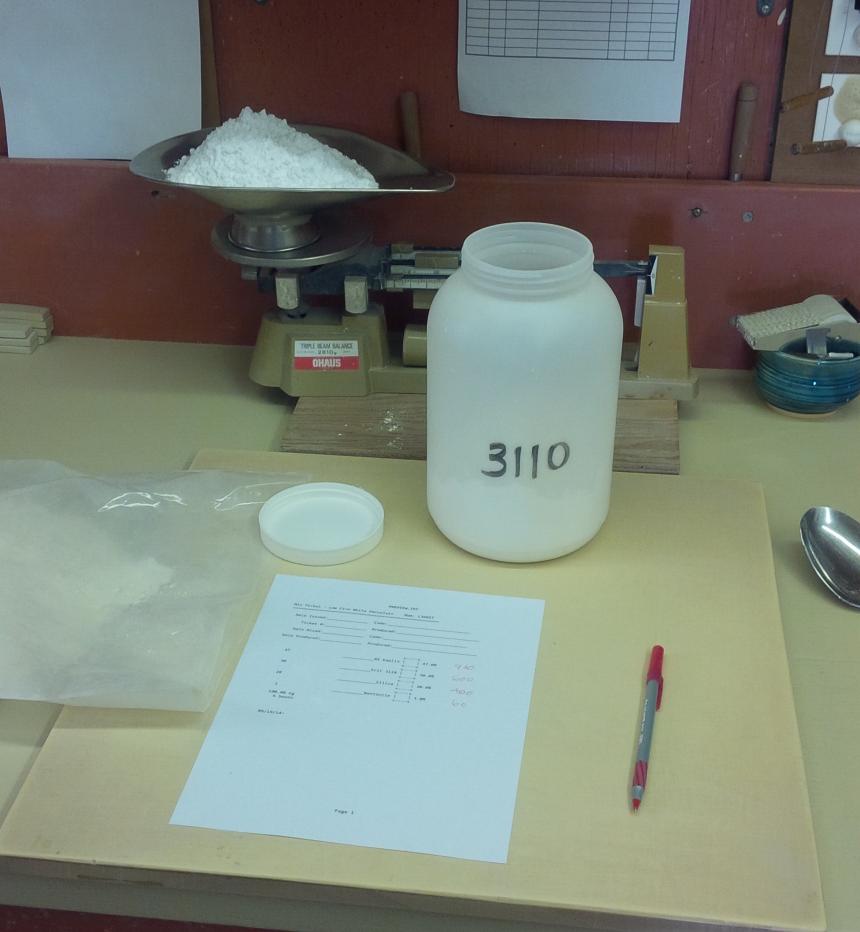| Monthly Tech-Tip | No tracking! No ads! |
A Low Cost Tester of Glaze Melt Fluidity
A One-speed Lab or Studio Slurry Mixer
A Textbook Cone 6 Matte Glaze With Problems
Adjusting Glaze Expansion by Calculation to Solve Shivering
Alberta Slip, 20 Years of Substitution for Albany Slip
An Overview of Ceramic Stains
Are You in Control of Your Production Process?
Are Your Glazes Food Safe or are They Leachable?
Attack on Glass: Corrosion Attack Mechanisms
Ball Milling Glazes, Bodies, Engobes
Binders for Ceramic Bodies
Bringing Out the Big Guns in Craze Control: MgO (G1215U)
Can We Help You Fix a Specific Problem?
Ceramic Glazes Today
Ceramic Material Nomenclature
Ceramic Tile Clay Body Formulation
Changing Our View of Glazes
Chemistry vs. Matrix Blending to Create Glazes from Native Materials
Concentrate on One Good Glaze
Copper Red Glazes
Crazing and Bacteria: Is There a Hazard?
Crazing in Stoneware Glazes: Treating the Causes, Not the Symptoms
Creating a Non-Glaze Ceramic Slip or Engobe
Creating Your Own Budget Glaze
Crystal Glazes: Understanding the Process and Materials
Deflocculants: A Detailed Overview
Demonstrating Glaze Fit Issues to Students
Diagnosing a Casting Problem at a Sanitaryware Plant
Drying Ceramics Without Cracks
Duplicating Albany Slip
Duplicating AP Green Fireclay
Electric Hobby Kilns: What You Need to Know
Fighting the Glaze Dragon
Firing Clay Test Bars
Firing: What Happens to Ceramic Ware in a Firing Kiln
First You See It Then You Don't: Raku Glaze Stability
Fixing a glaze that does not stay in suspension
Formulating a body using clays native to your area
Formulating a Clear Glaze Compatible with Chrome-Tin Stains
Formulating a Porcelain
Formulating Ash and Native-Material Glazes
G1214M Cone 5-7 20x5 glossy transparent glaze
G1214W Cone 6 transparent glaze
G1214Z Cone 6 matte glaze
G1916M Cone 06-04 transparent glaze
Getting the Glaze Color You Want: Working With Stains
Glaze and Body Pigments and Stains in the Ceramic Tile Industry
Glaze Chemistry Basics - Formula, Analysis, Mole%, Unity
Glaze chemistry using a frit of approximate analysis
Glaze Recipes: Formulate and Make Your Own Instead
Glaze Types, Formulation and Application in the Tile Industry
Having Your Glaze Tested for Toxic Metal Release
High Gloss Glazes
Hire Us for a 3D Printing Project
How a Material Chemical Analysis is Done
How desktop INSIGHT Deals With Unity, LOI and Formula Weight
How to Find and Test Your Own Native Clays
I have always done it this way!
Inkjet Decoration of Ceramic Tiles
Is Your Fired Ware Safe?
Leaching Cone 6 Glaze Case Study
Limit Formulas and Target Formulas
Low Budget Testing of Ceramic Glazes
Make Your Own Ball Mill Stand
Making Glaze Testing Cones
Monoporosa or Single Fired Wall Tiles
Organic Matter in Clays: Detailed Overview
Outdoor Weather Resistant Ceramics
Painting Glazes Rather Than Dipping or Spraying
Particle Size Distribution of Ceramic Powders
Porcelain Tile, Vitrified Tile
Rationalizing Conflicting Opinions About Plasticity
Ravenscrag Slip is Born
Recylcing Scrap Clay
Reducing the Firing Temperature of a Glaze From Cone 10 to 6
Setting up a Clay Testing Program in Your Company
Simple Physical Testing of Clays
Single Fire Glazing
Soluble Salts in Minerals: Detailed Overview
Some Keys to Dealing With Firing Cracks
Stoneware Casting Body Recipes
Substituting Cornwall Stone
Super-Refined Terra Sigillata
The Chemistry, Physics and Manufacturing of Glaze Frits
The Effect of Glaze Fit on Fired Ware Strength
The Four Levels on Which to View Ceramic Glazes
The Majolica Earthenware Process
The Potter's Prayer
The Right Chemistry for a Cone 6 MgO Matte
The Trials of Being the Only Technical Person in the Club
The Whining Stops Here: A Realistic Look at Clay Bodies
Those Unlabelled Bags and Buckets
Tiles and Mosaics for Potters
Toxicity of Firebricks Used in Ovens
Trafficking in Glaze Recipes
Understanding Ceramic Materials
Understanding Ceramic Oxides
Understanding Glaze Slurry Properties
Understanding the Deflocculation Process in Slip Casting
Understanding the Terra Cotta Slip Casting Recipes In North America
Understanding Thermal Expansion in Ceramic Glazes
Unwanted Crystallization in a Cone 6 Glaze
Using Dextrin, Glycerine and CMC Gum together
Volcanic Ash
What Determines a Glaze's Firing Temperature?
What is a Mole, Checking Out the Mole
Where do I start in understanding glazes?
Why Textbook Glazes Are So Difficult
Working with children
What is the Glaze Dragon?
Description
At Digitalfire we use a Dragon to personify the kinds of thinking that prevent potters, educators and technicians from understanding and therefore controlling their ceramic glazes.
Article
I fight the "Glaze Dragon". If you are experienced enough to understand ceramics, the dragon may not threaten you. But if you are "spinning your wheels" this could be the reason.

The Glaze Dragon personifies the **attitudes** that counter your desire, ability and efforts to understand and control your glazes
- The Glaze Dragon is attitudes. They counter your efforts, control, and confidence in making ware that is truly functional, durable and safe.
- This is no joke, he could easily rob you of your potential, make you waste years on blind alleys and dead ends.
- In ceramics things don't work a lot! He'll make sure you learn nothing when things don't work. You need to know about this D-R-A-G-O-N!
Dreaming
The dragon wants you to be a dreamer, having blind faith in textbook and internet recipes and believing you will never need to learn anything technical. The 'textbook glaze culture' continues to dominate among potters and small manufacturers; it pursues a 'universal', 'foolproof' recipe that exists only in dreamland. The **'recipe trade'** fosters a helplessness that neither 'understands' or controls recipes, that is a **slave** of fifty recipes that don't work instead of being a master of one or two that do. Industry is still driven by a 'salesman model' where companies trustingly use recipes and materials recommended by salesman and depend on the expertise of biased suppliers and consultants.
Roulette Wheel Approach
Pottery students are still taught to spin the 'roulette wheel' of glaze tests in the blind **hope** that one will actually work, not only looking great but also having good application properties, reliability, hardness and durability, resistance to leaching and staining, fit, adjustability, etc. This spawns generations of students who discover hundreds of recipes that don't travel well and who lack skills to recognize or create ones that do. Manufacturers often lack knowledge about alternate formulations and material brands and gamble that what they have is optimized to their process. They spend millions on equipment but overlook the materials.
Apathy Toward Glaze Science
The dragon promotes casual attitudes and lack-of-conscience regarding ware durability, functionality, and safety even though modern methods, materials, equipment, and information afford great control. He wants potters to think they are **exempt** from technical concerns, that no simple methods exists to assess glaze quality, that they will never be held **accountable** for deficient surfaces that hurt the reputation of the pottery and ceramic industry.
Gluttony For Punishment

The dragon is delighted when you **learn nothing** when recipes do not work. When you 'spin your wheels' and **waste years** on blind alleys and dead ends he wants you to blame your supplier or your consultant yet continue in the faith that that 'perfect' glaze is just around the corner. Of course, he wants you to forget all the disappointments that this prevailing culture has brought you and keep buying recipe books and the bags of odd-ball materials they call for. He also wants to you struggle with glazes, having problems with them settling, dripping, dusting, cracking, going on unevenly and drying slowly .. thinking that these headaches are worth it for the way they sometimes fire in the kiln.
Oversimplification
The dragon supplies 'blinders' so that you believe everything should be simple or not worth doing. You need not concern yourself with technical issues, understand your materials or have in-house expertise at your operation. He advocates abdication of control to suppliers and consultants or relying on friends. I-don't-need-to-knowers sacrifice only to the god of form and surface, left-brained thinking is off-limits.
Naked Undocumented Recipes, Materials
The dragon encourages authors not to 'dress' recipes for travel (by supplying information about special mechanisms, why specific materials are used, how to adjust for expansion, surface, temperature, special firing or application techniques, etc.). He then match-makes doomed affairs between ceramists and these naked recipes leaving many disillusioned and ill-equipped to recognize true glaze quality. Traveling glaze recipes that have **amnesia** about who they are, why they are, where they've been move on and leave alienated people stuck with storage rooms full of mystery materials as reminders of the broken promises. The dragon encourages material suppliers to provide data sheets that supply little or no practical information on exactly what the material is or does, the rationale behind its use in bodies or glazes. Users constantly feel that there are other better suited materials out there but the prevailing 'don't-need-to-know' culture keeps them in obscurity.
Related Information
The glaze dragon!

This picture has its own page with more detail, click here to see it.
There are many mindsets that prevent us to getting control of our glazes. Many of them have nothing to do with the glazes themselves, the problem is with us, our culture as ceramists and potters.
Are we collectively losing the simple ability to weigh out a glaze recipe?

This picture has its own page with more detail, click here to see it.
For potters, prepared glazes are starting to hurt control, independence and sense of responsibility regarding the quality of ware. Many potters are losing very basic abilities and concepts. Some potters are unaware of even what weighing out a glaze is! Some do not know how to recalculate a recipe total! Or even what a gram is or millilitre are. Or the purpose of ceramic materials like a frits, feldspars, kaolins, or silica. Or even where to buy them? Or the difference between a suspension and a solution. Or what specific gravity and viscosity are. Is this a trend we want?
Fight the dragon on-line or off-line

This picture has its own page with more detail, click here to see it.
Fight the glaze dragon! Test. Document. Learn. Repeat. Replace that paper notebook or binder with an account at Insight-live.com. Fix, adjust, formulate your own glaze on your PC using desktop Insight software.
Fight the dragon with Insight-live

This picture has its own page with more detail, click here to see it.
Fight the glaze dragon. Disorganized documentation of your testing? You are playing into his hands. Replace that notebook or binder with pictures, recipes, firing schedules, test results, material and more in your own or a group account at insight-live.com.
We fight the dragon that others do not see

This picture has its own page with more detail, click here to see it.
There are thousands of ceramic glaze recipes floating around the internet. People dream of finding that perfect one, but they often only think about the visual appearance, not of the usability, function, safety, cost or materials. That resistance to understanding your materials and glazes and learning to take control is what we personify as the dragon. Using the resources on this site you could be fixing, adjusting, testing, formulating your own glaze recipes. Start with your own account at insight-live.com.
Links
| Articles |
Glaze Recipes: Formulate and Make Your Own Instead
The only way you will ever get the glaze you really need is to formulate your own. The longer you stay on the glaze recipe treadmill the more time you waste. |
| Articles |
G1214M Cone 5-7 20x5 glossy transparent glaze
This is a base transparent glaze recipe developed for cone 6. It is known as the 20x5 or 20 by 5 recipe. It is a simple 5 material at 20% each mix and it makes a good home base from which to rationalize adjustments. |
| Articles |
Trafficking in Glaze Recipes
The trade is glaze recipes has spawned generations of potters going up blind alleys trying recipes that don't work and living with ones that are much more trouble than they are worth. It is time to leave this behind and take control. |
| Projects |
Troubles
|
| Typecodes |
Magic of Fire book
|
| By Tony Hansen Follow me on        |  |
Got a Question?
Buy me a coffee and we can talk

https://digitalfire.com, All Rights Reserved
Privacy Policy
